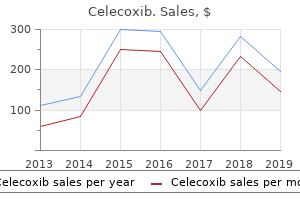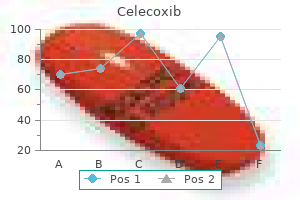

"Purchase celecoxib, arthritis in shoulder+neck+symptoms".
By: R. Murat, M.B. B.CH. B.A.O., M.B.B.Ch., Ph.D.
Deputy Director, Roseman University of Health Sciences
Although cleanliness arthritis pain tylenol or advil buy celecoxib with mastercard, hygiene treating elbow arthritis in dogs effective 200mg celecoxib, and aseptic management of lesions can control the unfold of staphylococci from lesions rheumatoid arthritis teeth generic celecoxib 200 mg online, few strategies are available to stop the wide dissemination of staphylococci from carriers. In hospitals, the areas at highest danger for severe staphylococcal infections are newborn nurseries, intensive care units, operating rooms, and most cancers chemotherapy wards. Massive introduction of "epidemic" pathogenic S aureus into these areas may lead to serious scientific disease. Personnel with lively S aureus lesions and carriers may should be excluded from these areas. Three weeks later (week 5), the an infection recurred, and she was given 2 extra weeks of intravenous vancomycin and again improved. Four weeks later (week 11), the infection recurred and the affected person was once more began on intravenous vancomycin. A radiograph of his arm shows a lytic lesion (dissolution) in the upper part of the humerus with periosteal elevation over the lesion. The affected person is taken to surgery, the place the lesion is debrided (dead bone and pus removed). Based on this information, you realize the organism is (A) Susceptible to nafcillin (B) -Lactamase positive (C) A producer of protein A (D) Encapsulated (E) Catalase optimistic three. This signifies that the organism is resistant to which of the following antibiotics Seven days in the past, a 27-year-old medical pupil returned from Central America, where she had spent the summer time working in a clinic for indigenous people. Pelvic examination exhibits she is having her menstrual period with a tampon in place; otherwise, the pelvic examination is regular. Her kidney function check (serum urea nitrogen and creatinine) results are abnormal, indicating gentle renal failure. Rifampin coupled with a second oral antistaphylococcal drug generally supplies long-term suppression and probably treatment of nasal carriage; this type of therapy is normally reserved for main problems of staphylococcal carriage because staphylococci can rapidly develop resistance to rifampin. To diminish transmission throughout the hospital setting, high-risk sufferers, such as those in intensive care units and patients transferred from persistent care facilities where prevalence is high, are frequently surveyed for anterior nares colonization. Health care staff should strictly adhere to infection management policies by sporting gloves and washing hands before and after patient contact. The pathogenic staphylococci, most importantly S aureus, hemolyze blood, coagulate plasma, and produce quite lots of extracellular enzymes and toxins that make them virulent. S aureus has advanced regulatory systems that reply to environmental stimuli to control the expression of its numerous virulence genes encoded on pathogenicity islands. Antimicrobial resistance amongst staphylococci could be fairly in depth, encoded by quite so much of mechanisms such as -lactamase production and chromosomal mecA, mecC, and different resistance determinants. Over a period of three weeks, a complete of five newborns within the hospital nursery developed Staphylococcus aureus infections with S aureus bacteremia. The isolates all had the same colony morphology and hemolytic properties and similar antimicrobial susceptibility patterns, suggesting that they were the identical. A 16-year-old bone marrow transplant patient has a central venous line that has been in place for two weeks. He additionally has a urinary tract catheter, which has been in place for two weeks as properly. He develops fever while his white blood cell rely could be very low and before the transplant has engrafted. The isolate is examined and found to be positive for the mecA gene, which means that (A) the isolate is susceptible to vancomycin. A group of six youngsters younger than eight years of age stay in a semitropical country. Each of the kids has a number of crusted weeping skin lesions of impetigo (pyoderma). Which of the following statements regarding the function of protein A within the pathogenesis of infections attributable to Staphylococcus aureus is right Which of the following staphylococcal organisms produces coagulase and has been implicated in infections following a dog chunk All of the following statements relating to Panton�Valentine leukocidin are appropriate besides (A) It is a two-component toxin. Which of the following statements best describes the function of the accent gene regulator in Staphylococcus aureus

The high incidence of salmonellae in commercially prepared chickens has been broadly publicized arthritis uk knee examination 200 mg celecoxib for sale. The incidence of typhoid fever has decreased arthritis medication without aspirin generic 100mg celecoxib free shipping, however the incidence of different Salmonella infections has elevated markedly in the United States arthritis cream discount 200mg celecoxib mastercard. The problem most likely is aggravated by the widespread use of animal feeds containing antimicrobial drugs that favor the proliferation of drug-resistant salmonellae and their potential transmission to humans. Carriers After manifest or subclinical an infection, some people proceed to harbor salmonellae in their tissues for variable lengths of time (ie, convalescent carriers or healthy everlasting carriers). Three p.c of survivors of typhoid turn out to be permanent carriers, harboring the organisms within the gallbladder, biliary tract, or, not often, the intestine or urinary tract. Members of this group are catalase positive; nitrate optimistic and, excluding Plesiomonas, are cytochrome oxidase negative. Sources of Infection the sources of infection are food and drinks which were contaminated with salmonellae. These antigens are virulence elements and can be utilized to serotype these organisms that possess them. Enterobacteriaceae trigger a selection of human infections that could be broadly categorised as both enteric ailments or extraintestinal infections similar to urinary tract infections, bacteremia, and meningitis. Genera related to enteric sicknesses embrace Salmonella, Shigella, and diarrheagenic E coli, of which there are six varieties primarily based on the mechanism of disease (eg, toxigenic or invasive or both). The commonest extraintestinal infections brought on by these organisms are urinary tract infections. E coli predominates, but the urea-positive organisms corresponding to Proteus species may cause bladder and kidney stones. Enterobacteriaceae acquired in the hospital surroundings are often immune to many antimicrobial brokers normally mediated by plasmid-encoded resistance determinants. A 20-year-old school student goes to the coed well being heart due to dysuria, frequency, and urgency on urination for twenty-four hours. The more than likely organism responsible for these signs and signs is (A) Staphylococcus aureus (B) Streptococcus agalactiae (C) Gardnerella vaginalis (D) Lactobacillus species (E) Escherichia coli 2. She works for an airline as a cabin attendant, flying between the Indian subcontinent and other places in Southeast Asia and the West Coast of the United States. Ten days before admission, she had a diarrheal sickness that lasted for about 36 hours. Her temperature is 39�C, coronary heart rate is sixty eight beats/ min, blood strain is 120/80 mm Hg, and respirations are 18 breaths/min. Blood cultures from the affected person in query 2 grow a non� lactose-fermenting gram-negative bacillus. The explanation for her urinary tract an infection is likely to be (A) Enterobacter aerogenes (B) Proteus mirabilis (C) Citrobacter freundii (D) Escherichia coli (E) Serratia marcescens An 18-year-old scholar has stomach cramps and diarrhea. Triple sugar iron agar is used to determine the isolates as salmonellae or shigellae. A end result suggesting one of these two pathogens would be (A) Production of urease (B) Motility in the medium (C) Inability to ferment lactose and sucrose (D) Fermentation of glucose (E) Production of gasoline within the medium An uncommon serotype of Salmonella enterica subspecies enterica was found by laboratories in the health departments of adjoining states. The isolates had been all from a small geographic area on either facet of the border between the states, suggesting a typical source for the isolates. Culture of the ulcer yields Staphylococcus aureus, Bacteroides fragilis, and a gram-negative bacillus that swarms across the blood agar plate covering the whole surface of the agar after 36 hours. The gram-negative bacillus is a member of the genus (A) Escherichia (B) Enterobacter (C) Serratia (D) Salmonella (E) Proteus A 4-year-old boy from Kansas City who recently started attending preschool and after-school daycare is introduced to his pediatrician for a diarrheal sickness characterised by fever to 38. His mom grew to become involved as a outcome of the stools are now blood tinged 24 hours into the sickness, and the kid seems fairly sick. The mom reports that two other kids who attend the same after-school daycare have just lately had diarrheal illness, certainly one of whom likewise had bloody stools. Which of the next is the most probably pathogen causing the sickness in these children A younger woman presents with recurrent urinary tract infections attributable to the same Proteus mirabilis strain.
Buy generic celecoxib 100 mg line. One Woman's Story On Beating Arthritis With A Healthy Diet.

The anterior 2/3 includes the anterior horns moderate arthritis in the knee discount 200mg celecoxib amex, spinothalamic tracts arthritis medication nhs buy cheap celecoxib 200 mg on-line, and corticospinal tracts equine arthritis relief cheap celecoxib 100 mg online. The anterior spinal artery lies within the midline on a ventral aspect of the wire, in the groove of the anterior median fissure. The posterior spinal arteries come up from the posterior rami of the vertebral artery or from the posterior inferior cerebellar artery. The posterior spinal arteries are a paired longitudinal system of vessels on the dorsal twine medial to the dorsal roots. The posterior spinal artery provides the posterior 1/3 of the twine, which includes provide to the posterior columns and a variable provide to the corticospinal tracts. Continuation of each the anterior and posterior spinal artery supply is derived from segmental anastomoses. These segmental vessels arise as dorsal rami from vertebral, subclavian, thoracic intercostal, and lumbar intercostal arteries. The dorsal rami enter the canal by way of the neural foramen after which penetrate the dura and divide into 2 primary branches: the dural artery, which supplies the nerve root sleeve and the dura, and the radiculomedullary branch. The radiculomedullary branch then divides right into a radicular artery, which penetrates the subarachnoid space to supply the anterior and posterior roots. There can be a variable medullary artery branch, which joins the anterior spinal artery and posterior spinal artery. The radicular arteries arise from the division of the radiculomedullary arteries along the anterior and posterior nerve roots. The anterior radicular artery extends along the anterior floor of the spinal twine, whereas the posterior radicular artery likewise extends alongside the posterior cord floor. The a number of fetal segmental vessels will regress with maturity, leaving 2-14 (average 6) anterior radicular arteries persisting in the adult and 11-16 posterior radicular arteries within the grownup. The major cervical radicular feeders to the spinal twine happen between the C5-C7 levels. There are 2-3 anterior cervical wire feeders that measure 400-600 microns in dimension. There are also 3-4 posterior cervical cord feeders, that are smaller in size, on the order of 150-400 microns. In the thoracic backbone, there are 2-3 anterior thoracic twine feeding segmental vessels. Small ventral feeding 431 Vascular Anatomy Spine: Neoplasms, Cysts, and Other Masses vessels may be current on the order of 200 microns. There is an inverse relationship between the quantity and caliber of ventral radicular vessels. There can occur "paucisegmental" anatomy with fewer vessels (< 5) with bigger caliber or "pluri-segmental" anatomy with more vessels with smaller caliber. The dominant thoracic anterior radicular artery can be referred to as the artery of Adamkiewicz. The artery of Adamkiewicz tends to have a left-sided origin (73%) and arises from T9-T12 (62%), with less frequent origins in the lumbar region (26%) and from T6-T8 (12%). A main segmental feeder may occur within the upper thoracic spine, typically the T5 degree. The number of posterior thoracic wire feeding vessels varies from 9-12, with a median of eight. The lumbosacral and pelvic regions have from 0-1 main feeding vessels to the spinal twine. The anterior spinal artery ends on the conus with speaking branches (rami cruciantes) to the posterior spinal artery. The posterior division of the iliac artery gives rise to the inferior and superior lateral sacral branches, which give rise to the spinal arteries through the anterior sacral foramen. The anterior division of the iliac artery gives rise to the inferior gluteal artery, which supplies the sciatic nerve.

Epidemiology arthritis in fingers thumb discount 200 mg celecoxib visa, Prevention arthritis in neck arm pain buy 100 mg celecoxib otc, and Control Shigellae are transmitted by "food does arthritis in the knee come and go buy celecoxib 200mg line, fingers, feces, and flies" from person to person. Shigellosis, triggered primarily by S sonnei, has turn into an necessary problem in daycare centers in the United States. Because humans are the main recognized host of pathogenic shigellae, control efforts must be directed at eliminating the organisms from this reservoir by (1) sanitary control of water, meals, and milk; sewage disposal and fly control; (2) isolation of sufferers and disinfection of excreta; (3) detection of subclinical cases and carriers, particularly food handlers; and (4) antibiotic remedy of infected individuals. They are transmitted from animals and animal products to humans, where they cause enteritis, systemic an infection, and enteric fever. The organisms nearly at all times enter via the oral route, often with contaminated food or drink. The imply infective dose to produce medical or subclinical infection in humans is 105�108 salmonellae (but perhaps as few as 103 S serotype Typhi organisms). Among the host factors that contribute to resistance to salmonella infection are gastric acidity, normal intestinal microbiota, and local intestinal immunity (see later). Salmonellae produce three main kinds of disease in people, however combined varieties are frequent (Table 15-4). The "Enteric Fevers" (Typhoid Fever) this syndrome is produced by only a few of the salmonellae, of which S serotype Typhi (typhoid fever) is the most important. The ingested salmonellae reach the small gut, from which they enter the lymphatics and then the bloodstream. After an incubation interval of 10�14 days, fever, malaise, headache, constipation, bradycardia, and myalgia happen. Rose spots, often on the pores and skin of the stomach or chest, are seen briefly in uncommon circumstances. In the preantibiotic era, the chief issues of enteric fever have been intestinal hemorrhage and perforation, and the mortality rate was 10�15%. The isolates are then despatched to reference laboratories for definitive serologic identification. This allows public well being officers to monitor and assess the epidemiology of Salmonella infections on a statewide and nationwide basis. Pathogenesis and Clinical Findings S serotype Typhi, S serotype, and maybe S serotype Paratyphi and S serotype Paratyphi B are primarily infective for humans, and an infection with these organisms implies acquisition from a human source. The overwhelming majority of salmonellae, nonetheless, are mainly pathogenic in animals that constitute the reservoir for human an infection; these embody poultry, B. Bacteremia With Focal Lesions this is associated commonly with S serotype choleraesuis however may be attributable to any salmonella serotype. Final identification-Suspect colonies from solid media are recognized by biochemical response patterns and slide agglutination tests with specific sera. In the United States, S Typhimurium and Salmonella Enteritidis are distinguished, but enterocolitis could be caused by any of the greater than 1400 group I serotypes of salmonellae. Blood tradition results are often adverse, however stool tradition results are positive for salmonellae and may remain optimistic for several weeks after medical restoration. Agglutination test-In this take a look at, identified sera and unknown culture are combined on a slide. This check is especially helpful for fast preliminary identification of cultures. There are business kits obtainable to agglutinate and serogroup salmonellae by their O antigens: A, B, C1, C2, D, and E. In enteric fevers and septicemias, blood culture outcomes are sometimes constructive within the first week of the disease. In enteric fevers, the stools yield constructive results from the second or third week on; in enterocolitis, the stools yield optimistic outcomes in the course of the first week. A optimistic tradition of duodenal drainage establishes the presence of salmonellae in the biliary tract in carriers. Bismuth sulfite medium permits speedy detection of salmonellae, which kind black colonies because of H2S production. Serum agglutinins rise sharply during the second and third weeks of S serotype Typhi an infection. The Widal check to detect these antibodies against the O and H antigens has been in use for decades. At least two serum specimens, obtained at intervals of 7�10 days, are needed to show an increase in antibody titer.